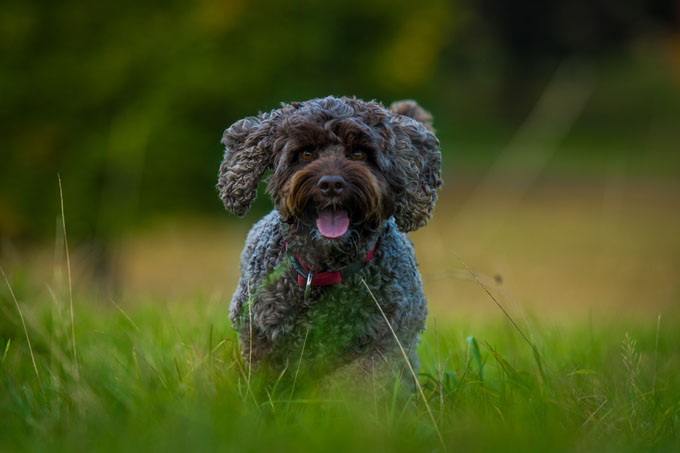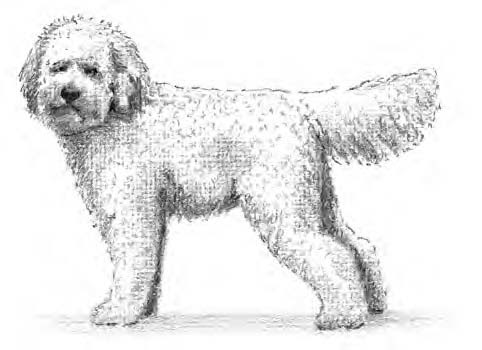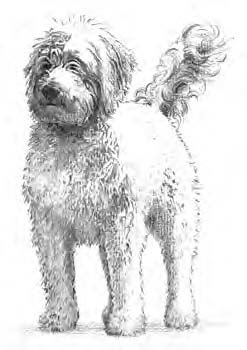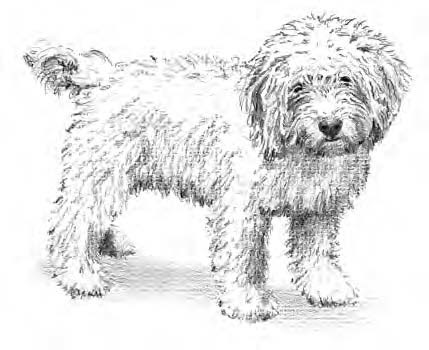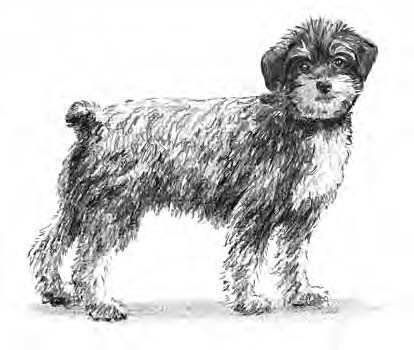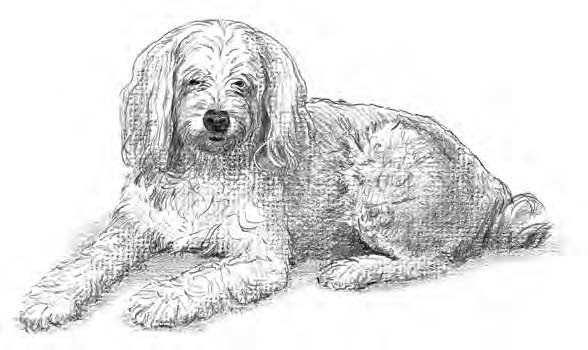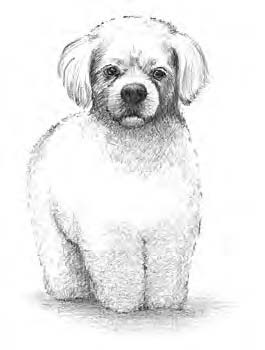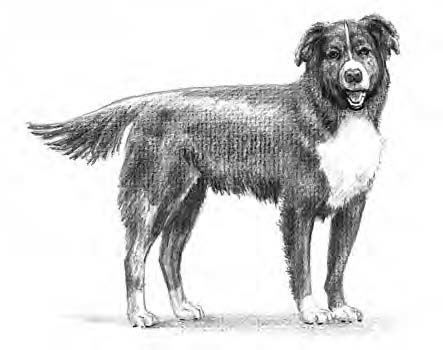In This Chapter
- Hearing the hype about hybrids
- Identifying the pros and cons of hybrid dogs
- Looking at the most popular designer dogs
What do James Gandolfini, Julianne Moore, Uma Thurman, and Jake Gyllenhaal have in common? No, they haven’t all won Oscars. They all have Puggles — the designer-dog hybrid of a Pug and a Beagle? Designer dogs are growing in popularity, and they’re often more expensive than purebred pups. Why? Because they’re unique.
So why would someone pay upwards of $1,500 for a mixed-breed dog when he can go to the local animal shelter and adopt one for $30? Aren’t all mixed-breed dogs unique in their own ways? Yes — but not all mixed-breed dogs purposely designed. Not all mixed-breed dogs have pedigreed parents. Not all mixed-breed dogs have a well-documented lineage. Designer dogs are carefully chosen to create a specific appearance and temperament in the offspring. The puppies are calculated, created, and planned. Most mixed-breed dogs are accidents — but there’s nothing accidental about a designer dog, and many people are willing to pay more to get one.
Designer dogs are not without controversy, though. Purebred dog fanciers (a fancy name for people who are enthusiastic about dogs) are vehemently opposed to mixing their purebred dogs with any other breed. In this chapter, I fill you in on the pros and cons of designer dogs, so you can decide for yourself whether they’re right for you. I also let you know which designer dogs are the most popular, and tell you a bit about those hybrids and what you can expect if you get one.
The Pros and Cons of Designer Dogs
Although breeders of designer dogs feel they’re meeting the needs of a particular niche of people, purebred breeders and purebred dog clubs, such as the American Kennel Club, think the entire trend is dangerous to all dogs. In the following sections, I offer up both sides of the debate and let you make up your own mind.
The pros
One of the advantages of designer dogs is the sheer number of varieties available. Over 200 different hybrid combinations exist, which means there is a designer dog for every taste. Most of these hybrids are small and designed to have good personality combined with adorability.
Designer dogs are created to fit every need — from pocket-size dogs for easy travel to low-shed dogs for those with allergies. Many of these designer-dog creations are free of some of the traits that can make life difficult for the purebred dog. For example, some purebreds, like the Pug, have a very short snout, making breathing difficult. But the popular Puggle — the hybrid of a Pug and a Beagle — has a longer nose while still maintaining the Pug’s wrinkled forehead and loopy gait.
Many hybrid breeders claim their dogs have hybrid vigor, a strength that comes from having parents of two different breeds. The offspring of two different breeds rarely inherit genetic defects, because the bloodlines aren’t as close as those of purebreds. Purebred dogs often have inherited traits that can cause genetic defects. For example, many retriever breeds tend to have cataracts or epilepsy, many large-breed dogs have hip dysplasia, and many small-breed dogs are prone to dental problems. Mixed-breed dogs rarely inherit these genetic defects, because their genetics are more varied. (Incidentally, this is true of all mixed-breed dogs, not just designer dogs or hybrids.)
The cons
The major con of designer dogs is the price. Most designer dogs cost upwards of $700, whereas many purebred dogs begin at $250.
Although each designer dog was bred for specific appearance and traits, there’s a good chance that some or all of them will not develop in the offspring. Mixing breeds is chancy, because the outcome is not absolute. Although purebred dog offspring will always mature to appear like the parent dogs, the hybrid offspring may appear more like one parent than the other, or have a personality more like one parent than the other. So, although you might be searching for a small Yorkipoo, the pup might grow up to be the size of a large Yorkshire Terrier instead of a Teacup Poodle.
As much as the breeders of designer dogs claim that mixing two breeds improves the offspring’s overall health, that fact is debatable. Although many of the puppies don’t show symptoms of the recessive genetic dysfunctions commonly seen in purebred dogs, many other puppies do. In fact, a hybrid puppy can have the poor luck to inherit the worst physical and temperament traits of both parents.
Remember
There are no guarantees when you get a dog — purebred, hybrid, or mutt.
The Major “Labels” in the Designer-Dog World
In the following sections, I introduce you to some of the most popular designer dogs.
Tip
I can’t cover all 200+ varieties of designer dogs in this chapter. But if you’re curious about the wide variety of designer dogs available, a great resource is the American Canine Hybrid Club (www.achclub.com).
Oodles of Poodles
Few hybrids are more popular than those with a Poodle parent. In fact, it was the Poodle mixture that started the entire fad of designer dogs, beginning with the Labradoodle and Cockapoo.
Poodles bring many great attributes into the hybrid crossing, plus they come in four sizes: Standard, Miniature, Toy, and Teacup (a size not currently recognized by the AKC). Plus, they’re low-to-no-shed dogs with dirt-resistant coats. When combined with a Retriever, or other straight soft-coated breed, they can produce a beautiful wavy or large-curl coat that’s very attractive.
The smaller Poodle breeds also tend to live a long time. So instead of having a dog for only 10 to 12 years, you’ll have one who will live upwards of 15 years. That, alone, makes a Poodle mix very attractive.
When compared to other purebred dogs, Poodles are rated high on the intelligence scale. They learn quickly and can work their way through problems faster than most other breeds. What’s not to like about fast housetraining? Poodles are sensitive, highly aware, and learn by watching others.
Unless very poorly bred, Poodles have few genetic defects, though they aren’t totally without health concerns. Their hips are far better than most retriever and shepherd breeds. They aren’t prone to heart problems seen in many types of dogs. And they rarely have epilepsy, retinal atrophy, or allergies. Overall, mixing any purebred dog with a Poodle will create great offspring.
Labradoodles (Labrador Retriever/Poodle)
Created as the ultimate service dog, Labradoodles (see Figure 2-1) quickly became popular around the world. Just as the Labrador Retriever is the most popular purebred dog in the United States, the Labradoodle is also the most popular, large designer dog.
Initially, Labradoodles were bred to aid people who needed service dogs, but were allergic to dog dander and fur. Labradoodles are large, solid, strong, and intelligent. They’re eager to learn and love to please their human companions. As with the purebred Labrador service dogs, Labradoodles can work all day without tiring. And they’re very loving. Labradoodles are ideal with children.
Warning!
Labradoodles don’t interact well with assertive people or dominant dogs. Any heavy-handed training technique, such as being yelled at or jerked around on a leash, will cause a Labradoodle to shut down and want to crawl into a corner.
Figure 2-1: Labradoodles have three coat types, two of which do shed.
Goldendoodles (Golden Retriever/Poodle)
Goldendoodles (see Figure 2-2) turn an already perfect family pet into a perfect family pet that sheds less. The mixing of the Golden Retriever and Poodle changes little about the offspring other than coat appearance. The majority of Goldendoodles have coats with golden hue, the structure generally similar to that of the retriever. But the coat changes from a long and smooth, sometimes wavy texture, to a scruffier, curlier, harsher texture.
Golden Retrievers are the ideal dog — they love to please their human companions, play ball, cuddle, play ball, go for long walks, play ball, fetch a stick in the water, or if you’re feeling like you want to play fetch for hours, fetch the ball in the water. They’re easy to train and easy to care for.
They’re energetic and playful outdoors and happy to rest at your feet or join in a quiet game indoors. Many will bark to let you know of visitors, though they don’t believe in strangers — after all, anyone can throw a ball.
Cockapoos (Cocker Spaniel/Poodle)
In Cockapoos (see Figure 2-3), generally the Poodle is the sire (father), and the Cocker Spaniel is the dam (mother). Adult Cockapoos mature from 10 to 30 pounds depending on the size of the parents (mainly the size of the sire) and the gender of the puppy. Their coat grows very long and sheds very little, if at all. Cockapoos require grooming every two to four months depending on the desired length of hair. This hybrid is excellent for families with allergies or asthma. They come in a variety of colors: buff, red, chocolate, black, white, and a variety of parti-colors.
Figure 2-2: Goldendoodles are a great combination of two great family dogs.
Figure 2-3: Cockapoos are great medium-sized dogs that shed very little, love to cuddle, and learn quickly.
Cockapoos are very patient and tolerant with children, and because they like to play and are durable, children like them. They may bark to alert you of intruders, but they rarely go beyond making noise — especially once the person is allowed inside.
Some Cockapoos can be very sensitive because both parent breeds have a tendency toward having their feelings hurt very easily. This is a great hybrid for the elderly, because Cockapoos are gentle, cuddly, and easy to care for.
Schnoodles (Miniature Schnauzer/Poodle)
Schnoodles (see Figure 2-4) are very loyal to their families. This hybrid is affectionate, extremely intelligent, easily trained, clever, friendly, fun loving, and loaded with personality! However, because they are half Schnauzer, they can also be willful, stubborn, and prone to excessive barking. Most Schnoodles are good with children and get along fine with other animals. They’re great watchdogs because they let you know when someone is near, but they aren’t aggressive.
This great companion dog excels in obedience, agility, and flyball. They make excellent therapy dogs. Schnoodles are loyal and loving companions. They’re comfortable in any environment — from an apartment to a farm — as long as they’re with their families.
Schnoodles are high-energy dogs outdoors, but they’re happy to warm your feet indoors. Because neither of the parent breeds — Poodle and Miniature Schnauzer — shed, the Schnoodle does not shed. This hybrid is easily maintained through weekly brushing and bimonthly clipping.
Figure 2-4: Schnoodles are medium-sized dogs with loads of personality.
Teripoos (Terrier/Poodle)
A Terripoo (see Figure 2-5) is any Terrier breed mixed with a Poodle. Because there are so many Terrier breeds, there are numerous types of Teripoos.
Figure 2-5: The Teripoo can learn to work as a therapy dog.
Although most Terripoos benefit from having Poodle blood, they’re still part Terrier, which means they have a stubborn streak, tend to be willful, and are prone to excessive barking and overall controlling personalities. However, you can’t ignore their adorable appearance and intelligence.
Peke-a-poos (Pekingese/Poodle)
Peke-a-poos (see Figure 2-6) are small dogs, often Toy-size, weighing from 9 to 20 pounds. Their coats are usually white or gray, but some are brown. The texture of the coat is very soft.
Peke-a-poos are fairly low maintenance with few of the common health problems associated with the Pekingese. However, because they are half Pekingese, they can have breathing difficulties common with the shortened nose. The other problem associated with a Peke-a-poo is tearing of the eyes, which can become a serious problem if the eyes become swollen or the tear stains are dark.
Peke-a-poos tend to inherit their parent Pekingese’s long, soft fur. Unless you want to brush your dog daily, keep your Peke-a-poo’s fur short, because a Peke-a-poo’s fur mats into dreadlocks very easily.
Peke-a-poos love to cuddle and have a medium energy level, making them ideal dogs for small homes and apartment living. They love to play outside for a short period of time, then sleep on your lap for a long period of time. Though very affectionate, they can be quite willful and stubborn, making housetraining difficult.
Figure 2-6: Peke-a-poos are lap potatoes, much like one of their parent breeds, the Pekingese.
A basket of Toys
There are more combinations of Toy hybrids than there are recognized purebred Toy breeds. Though small, they’re still dogs and should be treated as such — not as mere arm ornaments. Toy hybrids tend to have good longevity, great personalities, and require the special care accorded to Toy dogs.
Warning!
So-called pocket dogs are usually a combination of two Toy breeds; the parents chosen more for their small size than anything else. The mixing of two Terrier-type Toys can mean a challenging personality. Also, the combining of two breeds that already have the tendency toward similar health issues, such as breathing difficulties or skin allergies, will likely result in puppies who have to contend with these same issues throughout their lives.
Bichon Frise hybrids
The Bichon Frise is a small, white, curly-coated dog with an antiallergenic coat. They require a lot of exercise and consistent training. Bichons are cute and cuddly, but also like to be in charge. Any Bichon Frise hybrid may tend to inherit these qualities, especially if one of the parents is a Terrier-type breed.
The American Canine Hybrid Club recognizes more than 25 Bichon Frise hybrids, ranging from the Griffichon (Bichon Frise/Brussels Griffon) to the Cock-a-Chon (Bichon Frise/Cocker Spaniel). To get the full list, go to
www.achclub.com.
Pug hybrids
Pugs are a popular breed for Toy hybrid dogs because they’re fairly hardy, sweet, intelligent, and have a short, easy-care coat. For large-dog enthusiasts, the Pug offers the appearance of a Mastiff (their ancestors) without the enormous size.
Pugs do have a few physical issues, however, because they’ve been bred to have extremely short noses, which cause many respiratory problems, and their legs are known to have problems with knee dislocation. Plus, this breed can be willful and stubborn.
Warning!
One of the biggest dangers of using Pugs in designer hybrid Toys is their eye configuration (they have protruding eyes) and short noses. Breeding them with other Toys with similar physical attributes can cause dangerous health issues.
Though Pugs are Toy dogs, they have a very ingrained alarm system. For hundreds of years they have alerted their human companions of coming danger, often saving the lives of those in their communities. If your hybrid Toy has Pug blood, you can be sure he’ll bark when he hears intruders!
The American Canine Hybrid Club recognizes more than 20 Pug hybrids, ranging from the Pugland (Pug/Westie) to the Puggle (Beagle/Pug), currently the most popular designer dog. To get the full list, go to
www.achclub.com.
Maltese hybrids
Though very small, Maltese have large personalities. They’re bold, are quick to sound the alarm when they hear something, and can be difficult to housetrain. Some can be snappy with children or with human companions who are inconsistent with their leadership role.
These small white dogs have long, silky fur and can grow to be 8 to 10 inches tall at the shoulder, weighing about 9 pounds. They have large, round eyes with dark rims, black noses, and a fine bone structure. Their bodies are slightly longer than they are tall, as is common with many Toy breeds.
Warning!
The Maltese may be small, but should not be overly pampered. Pampering makes them jealous of others, causing aggressive reactions. These traits are very possible in the hybrid offspring.
Maltese are prone to sunburn on their skin, respiratory problems due to their very short noses, eye irritation due to their somewhat bulging eyes, and tooth problems, a common Toy dog malady.
The American Canine Hybrid Club recognizes nearly a dozen Maltese hybrids, ranging from the Mauzer (Maltese/Miniature Schnauzer) to the Silkese (Maltese/Silky Terrier). To get the full list, go to
www.achclub.com.
Pekingese hybrids
Pekingese have long, straight coats with profuse feathering. They come in all colors and grow to about 9 inches tall at the shoulder, weighing 8 to 10 pounds. One of the reasons for their popularity among hybrid dog breeders is that many Pekingese can be found at under 6 inches in height and weighing under 6 pounds, creating a great parent base for a pocket-size dog.
This Toy dog tends to have a broad head with wide-set dark eyes, a wrinkled short muzzle, and drooping heart-shaped ears with long feathering. Their necks are short and thick. Like the Pug, they have a rolling gait.
Pekingese are very brave, independent, and affectionate with their own people but wary of strangers. They can be obstinate, willful, and finicky. Due to their sensitivity to sound and movement, they tend to be excessive barkers.
Warning!
This Toy breed tends to catch colds easily and is prone to herniated disks, dislocated kneecaps, trichaiasis (eyelashes growing inward, toward the eyeballs), and breathing problems due to their shortened snouts. Heart problems are also a common health issue in Pekingese. As with many other Toy breeds, they have a tendency to easily become overweight so should never be fed a high-calorie diet.
The American Canine Hybrid Club recognizes numerous Pekingese hybrids, ranging from the Foxingese (Pekingese/Toy Fox Terrier) to the Yorkinese (Pekingese/Yorkshire Terrier). To get the full list, go to
www.achclub.com.
Shih Tzu hybrids
Though Shih Tzus look like Lhasa Apsos, their personalities are totally the opposite. Where Lhasas are dominant and willful, Shih Tzus are gentle, easy-going, and very willing to learn. They’re happy, hardy, and have loads of character. It’s no wonder that this is a popular addition to many hybrid dog combinations.
They grow up to 11 inches tall at the shoulder and weigh about 9 pounds, though they do have a tendency to become overweight because they’re very food oriented. They have round heads, short noses, and lots of fur around their faces. Shih Tzus have long, soft overcoats with a woolly undercoat, making them fairly hardy in extreme temperatures for short periods of time. Their tails curl over their backs, and they come in a huge variety of colors.
Because of their short noses, they wheeze and snore, along with having respiratory problems from time to time. They can have spinal disc disease due to their long back and short legs. However, compared to many Toy breeds, their genetic defects are few.
Warning!
Though it has been done, Shi Tzus should not be bred with other dogs who have similarly short noses and large bulging eyes. This can create some horrendous health issues with the hybrid pups.
The American Canine Hybrid Club recognizes more than 25 Shih Tzu hybrids, ranging from the Fo-Tzu (Shih Tzu/Toy Fox Terrier) to the Bea-Tzu (Beagle/Shih Tzu). To get the full list, go to
www.achclub.com.
Pomeranian hybrids
Pomeranians resemble foxes, only with thicker, fluffier fur. Their wedge-shaped heads; straight, triangular ears; and pointed noses are fox-like, as are their babydoll faces. Poms have dark, almond-shaped eyes and a double coat, which can be any solid color, though there are some that are parti-colored, such as black and white.
Descended from Nordic breeds bred to withstand extremely cold temperatures and work all day pulling sleds, Pomeranians are some of the hardiest of the Toy breeds. Poms aren’t big enough to pull a sled (though if you put about ten of them together, they’d give it a good try), but they still believe they’re big, tough dogs. This makes them willful, bold, and often temperamental — though not stupid. If you use a positive training technique with lots of incentive, your Pom will do whatever you want.
Pomeranians are a popular parent breed for hybrid dogs because they offer the beautiful fluffy coat, distinct facial features, and small size. The average Pom doesn’t grow much larger than 12 inches tall at the shoulder and weighs a mere 7 pounds.
Warning!
Though Pomeranians are tough little dogs, they do have a genetic tendency toward specific health issues, including luxating patella (the kneecap slips out of its proper groove and moves against the thighbone), heart and skin problems, as well as eye infections. Also, as with most Toy breeds, they are prone to dental problems and weight gain.
Because Pomeranians have large, bulging eyes and the tendency toward specific health problems, they should not be bred with breeds that have similar attributes.
The American Canine Hybrid Club recognizes more than 25 Pomeranian hybrids, ranging from the Pom-Coton (Pomeranian/Coton de Teluar) to the Poshies (Pomeranian/Shetland Sheepdog). To get the full list, go to
www.achclub.com.
Yorkshire Terrier hybrids
Yorkies are very small toys with a long silky coat that falls straight down on either side. Although the puppies are usually black and tan, they mature to steel gray and gold. This breed has a flat head, medium-length muzzle, black nose, and upright V-shaped ears. This is another Toy dog who doesn’t have a small personality — they are Terriers, after all. As tenacious as they come, Yorkshire Terriers have a high energy level, are aggressive with strangers and other dogs, are demanding of attention, and are territorial. Yorkies are often spoiled and catered to due to their small size (a mere 7 inches tall at the shoulder, and hardly ever more than 7 pounds). This coddling creates a mini-monster. Yorkshire Terriers, as with dogs of any size, need structure and leadership.
Warning!
Yorkies do have some genetic health problems. These include abnormal skull formations, paralysis of the hindquarters caused by herniated discs, and other spinal problems. They are also prone to dental abnormalities and excessive tooth decay. They have a poor tolerance to anesthetics and a tendency toward congenital liver disease.
The American Canine Hybrid Club recognizes more than 15 Yorkshire Terrier hybrids, ranging from the Fourche Terrier (West Highland White Terrier/Yorkshire Terrier) to the Snorkie (Miniature Schnauzer/Yorkshire Terrier). To get the full list, go to
www.achclub.com.
Intelligent perceptions: Border Collie hybrids
People who want to create a hybrid based on intelligence and not coat type will often use the Border Collie breed as one of the parents. One of the positive outcomes of using Border Collies in a hybrid crossing is that they have few genetic health problems.
Borador (Border Collie/Labrador Retriever)
The Borador (see Figure 2-7) is often medium to large with large feet, a long muzzle, and light brown eyes; some have upright ears. The coat can be either medium length or short with any combination of colors ranging from all yellow to all black or with typical Border Collie white around the neck, on the paws, and on the nose.
Figure 2-7: Here’s a typical Borador. You can see both breeds very clearly in this dog.
These two breeds complement each other well. Where the Border Collie might be overly sensitive, the Labrador Retriever is bold. Where a Lab may not be able to figure something out, the Border Collie puts in reason. Where a Border Collie might constantly want to chase farm animals and round them up, the Lab feels more relaxed about work, more likely to wait for the cues from his human companions instead of striking out to work on his own.
In all, Boradors are easy to care for, easy to train, friendly, and often very healthy. They’re wonderful companions.
Bordernese (Bernese Mountain Dog/Border Collie)
A Bordernese (see Figure 2-8) appears much like a Border Collie only larger. The coloring of the coat is similar with black and white, sometimes tan eyebrows. The coat texture is also similar; long, smooth, and thick. Both breeds have long muzzles, dark eyes, and long tails with a slight upward curve.
Figure 2-8: The Bordernese looks very much like a larger Border Collie with the added tan highlights over the eyes.
Both breeds were developed as herding dogs. Therefore, both are very intelligent and easy to train. The difference in temperament lies in the Border Collie being a higher-energy worker than the Bernese Mountain Dog and also far more sensitive. Border Collies generally don’t interact well with children, whereas the Bernese Mountain Dog adores children.
Warning!
Mixing these two breeds together creates a larger herding dog with a medium energy level and fairly outgoing personality. However, Bernese Mountain Dogs don’t have the same longevity of a Border Collie, so the hybrid offspring may not either. Another issue with mixing these two breeds together is that both are prone to the same genetic defects such as hip and elbow dysplasia, eye problems, and heart problems. Border Collies also might have horrendous allergic reactions to flea bites, as well as epilepsy. The hybrid offspring are highly likely to not have good hybrid vigor.
by Miriam Fields-Babineau
